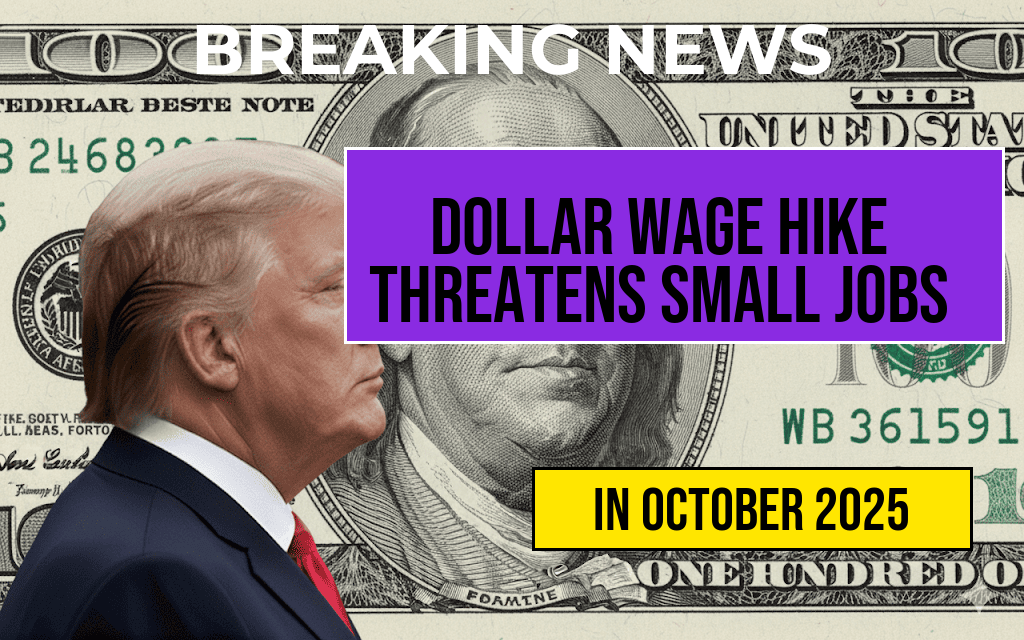A proposed increase of just $1 in the minimum wage could have outsized repercussions for small businesses nationwide, potentially prompting layoffs or reduced staffing levels amidst rising concerns over automation and labor costs. While advocates argue that such a modest wage hike supports low-income workers, critics warn that even incremental increases can strain tight profit margins, especially for small firms that lack the economies of scale of larger corporations. As policymakers debate the merits of raising the minimum wage across various states and municipalities, small business owners grapple with the possibility that increased labor expenses may accelerate automation efforts or force difficult employment decisions.
The Economic Context of a $1 Wage Increase
Over the past decade, discussions surrounding minimum wage adjustments have often centered on larger figures—$15 per hour being the most prominent. However, a recent legislative proposal aims to raise wages incrementally, advocating for a $1 increase in certain regions. Though seemingly modest, this change could have ripple effects, especially for small businesses operating with razor-thin profit margins. According to data from the Wikipedia entry on minimum wage, even small adjustments can impact employment levels, particularly where labor costs constitute a significant portion of expenses.
Small Business Perspectives and Challenges
Financial Strain and Profit Margins
- Many small firms report that their profit margins hover around 3-5%, leaving little room for wage increases without offsetting cuts elsewhere.
- For businesses in retail, hospitality, and service sectors, labor costs can account for up to 50% of total expenses, making wage hikes a sensitive issue.
- Some business owners express concern that even a $1 per hour increase could necessitate reductions in staff hours or layoffs to maintain financial viability.
Automation as a Response
As labor costs rise, some small businesses consider adopting automation technologies—like self-service kiosks, robotic cleaners, or automated checkout systems—to offset increased wages. Industry experts note that automation adoption has accelerated in recent years, driven by technological advancements and the need to remain competitive in a tight labor market. A report from Forbes highlights that automation can reduce long-term labor costs but often requires upfront investments that small businesses may find challenging.
Potential Employment Impacts
Job Cuts and Reduced Hours
| Response Type | Description | Estimated Frequency |
|---|---|---|
| Layoffs | Reducing staff to offset higher wages, particularly among entry-level or less experienced workers. | Likely in sectors with tight margins, such as retail and hospitality. |
| Hiring Freezes | Postponing new hires to prevent wage-related cost increases. | Common among small firms with fluctuating revenue streams. |
| Reduced Hours | Cutting employee hours rather than jobs to manage labor costs. | Frequent in restaurants and service industries. |
Balancing Wage Increases and Business Sustainability
Policy advocates maintain that a modest wage hike can boost worker productivity, reduce turnover, and foster economic stability for low-income households. Studies, such as those cited by the Brookings Institution, suggest minimal negative employment effects at small scale increases. However, the immediate financial pressures on small businesses remain a significant concern, especially in the face of persistent inflation and rising operational costs.
The Broader Automation Trend and Future Outlook
Automation is increasingly viewed as a strategic response to rising wages. As technology becomes more accessible and affordable, small businesses may turn to automation not just to cut costs but to improve efficiency and customer experience. Nonetheless, the decision to automate involves weighing upfront investments against long-term savings, a calculus that many small operators find daunting during uncertain economic times.
Expert Insights and Policy Considerations
Economists caution that while small wage increases aim to support low-wage workers, policymakers must consider the potential for unintended consequences. Dr. Lisa Green, an economist specializing in small business dynamics, notes, “Even a dollar increase can tip the balance for some small enterprises, especially those already operating with thin margins. It’s essential to pair wage policies with support measures, such as grants or tax incentives for automation upgrades, to help small firms adapt.”
As the debate continues, small business owners, workers, and policymakers will need to navigate the complex interplay between fair wages, employment levels, and technological advancement. The challenge lies in fostering an environment where wage growth does not inadvertently threaten the viability of local businesses that serve as vital economic engines in communities across the country.
Frequently Asked Questions
What are the potential impacts of a one-dollar minimum wage increase on small businesses?
A one-dollar wage increase could lead small businesses to face higher labor costs, which might result in cost-cutting measures such as reducing jobs or limiting hiring to maintain profitability.
How might automation influence the effects of a wage increase on small businesses?
With rising labor costs, small businesses might be more inclined to invest in automation technologies to replace human labor, potentially leading to job losses despite the wage increase.
Are small businesses likely to cut jobs if the minimum wage is increased by a small amount?
The decision depends on various factors, but some small businesses may consider cutting jobs or reducing hours if the wage increase significantly impacts their profit margins, especially in highly competitive or low-margin industries.
What strategies can small businesses adopt to manage increased wage costs without resorting to layoffs?
Small businesses can explore productivity improvements, pricing strategies, or training programs to offset higher wages, as well as leveraging automation to maintain service levels without reducing employment.
Does a modest wage increase have long-term benefits for small businesses and their employees?
Yes, a small wage increase can boost employee morale, reduce turnover, and improve productivity, which may contribute to long-term growth despite short-term challenges associated with higher labor costs.






